Search the Special Collections and Archives Portal
Search Results

Photograph of an artist's rendering of the Dunes Hotel sign (Las Vegas), circa 1955
Date
Archival Collection
Description
Artist's concept of the Dunes Hotel sign. Stamped on original: "Frank and Virginia Ball Studio - 222 South 2nd Street - Las Vegas, Nevada."
Site Name: Dunes Hotel
Address: 3650 Las Vegas Boulevard South, Las Vegas, NV
Image
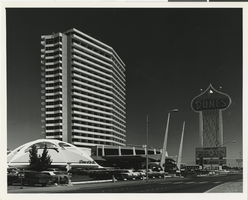
Photograph of the Dunes Hotel exterior (Las Vegas), circa 1970s
Date
Archival Collection
Description
The Dunes Hotel from the Strip showing the Diamond of the Dunes tower addition. Stamped on original: "Las Vegas News Bureau. Convention Center. Las Vegas, Nevada, 29572, Don English, Tony King, Gary Angell, Jerry Abbott, John Litty, Milt Palmer, Wolf Wergin, Lee McDonald, Cliff Stanley."
Site Name: Dunes Hotel
Address: 3650 Las Vegas Boulevard South, Las Vegas, NV
Image

Aerial photograph of the Dunes Hotel (Las Vegas), circa 1960s
Date
Archival Collection
Description
The Dunes Hotel and golf course from the air in the 1960s. Print version was created from negative film-- the image on the photograph is reversed.
Site Name: Dunes Hotel
Address: 3650 Las Vegas Boulevard South, Las Vegas, NV
Image
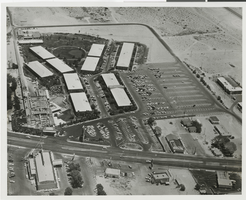
Aerial photograph of the Sands Hotel looking East (Las Vegas), early 1960s
Date
Archival Collection
Description
Aerial view of the Sands Hotel and adjacent property in the 1960s.
Site Name: Sands Hotel
Address: 3355 Las Vegas Boulevard South
Image
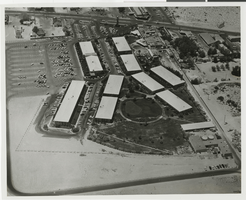
Aerial photograph of the Sands Hotel looking West (Las Vegas), early 1960s
Date
Archival Collection
Description
Aerial view of the Sands Hotel and adjacent property in the 1960s.
Site Name: Sands Hotel
Address: 3355 Las Vegas Boulevard South
Image
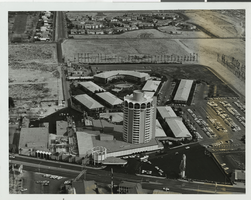
Aerial photograph of the Sands Hotel (Las Vegas), late 1960s
Date
Archival Collection
Description
Aerial view of the Sands Hotel after the addition of the tower. Stamped on original: "Las Vegas News Bureau. Las Vegas, Nevada,Convention Center. 12844, Don English, Jerry Abbott, Joe Buck, Milt Palmer, John Cook."
Site Name: Sands Hotel
Address: 3355 Las Vegas Boulevard South
Image
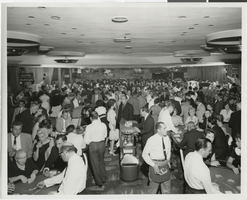
Photograph of the Sands Hotel casino interior (Las Vegas), 1959
Date
Archival Collection
Description
The interior of the Sands Casino in 1959. Stamped on original: "Las Vegas News Bureau. Las Vegas, Nevada, Convention Center. Photographers- Don English, Jerry Abbott, Joe Buck, Milt Palmer, 7906."
Site Name: Sands Hotel
Address: 3355 Las Vegas Boulevard South
Image
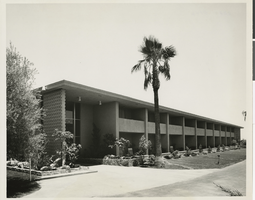
Photograph of the Hollywood Park guest wing at the Sands Hotel (Las Vegas), 1950s
Date
Archival Collection
Description
Hollywood Park - one of five two-story buildings which housed guests at the Sands in the 1950s. The five buildings were all named after famous American racetracks.
Site Name: Sands Hotel
Address: 3355 Las Vegas Boulevard South
Image
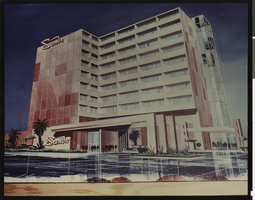
Photograph of an artist's rendering of a proposed high-rise building for the Sands Hotel (Las Vegas), 1961
Date
Archival Collection
Description
Artist's rendering of a proposed and unbuilt tower for the Sands.
Site Name: Sands Hotel
Address: 3355 Las Vegas Boulevard South
Image
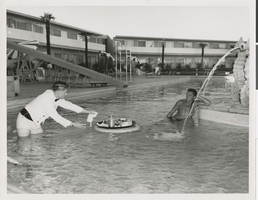
Photograph of a waiter serving breakfast in the Dunes Hotel swimming pool (Las Vegas), 1955
Date
Archival Collection
Description
Waiter in half-swim attire serving a guest in the pool. Stamped on original: "Las Vegas News Bureau. Las Vegas - Nevada. Photographers: Don English - Joe Buck - Jerry Abbott;" Staple holes in bottom left corner.
Site Name: Dunes Hotel
Address: 3355 Las Vegas Boulevard South
Image
